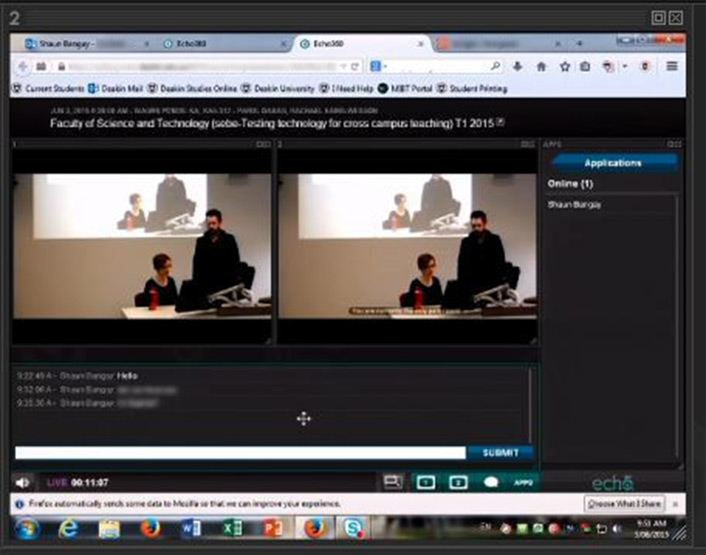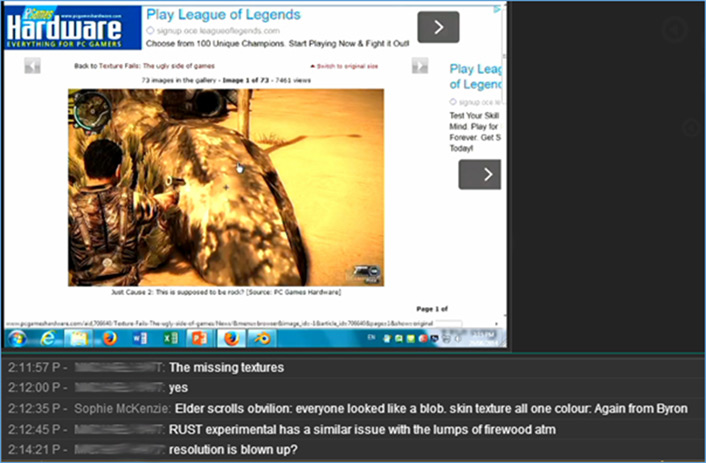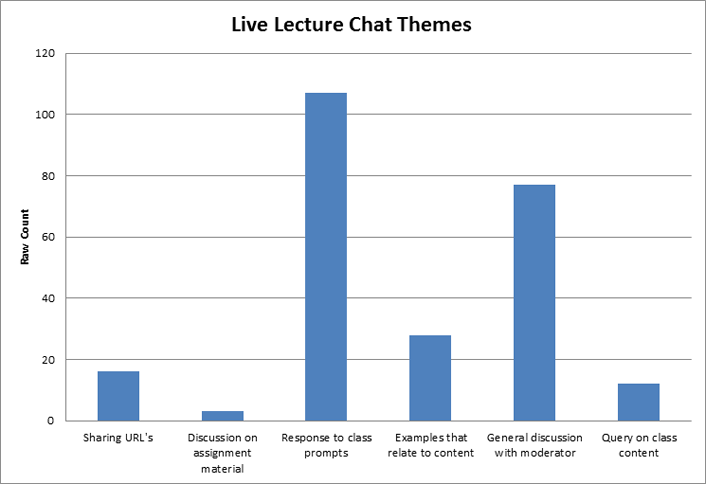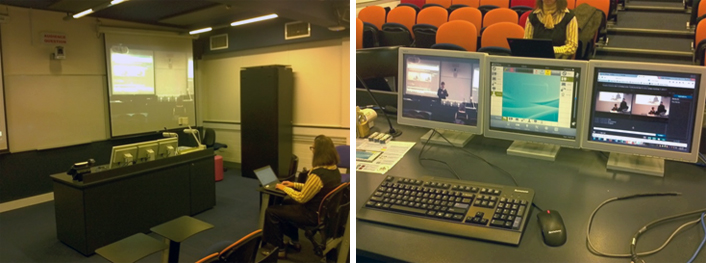Key Takeaways
- Using live streaming with blended learning helps engage off- and on-campus students in real time and enhances the off-campus experience by incorporating synchronous activities in addition to the usual asynchronous interactions.
- Research into the effective use of blended learning frameworks offers opportunities to create course experiences that are personal, relevant, and engaging.
- Challenges include integrating appropriate technology and managing it effectively throughout the course.
- Results from practical experiments will likely guide future learning and teaching endeavors using technology for inclusive, interactive, and collaborative learning for on- and off-campus students.
Rachael Hains-Wesson, Senior Lecturer in Work-Integrated Learning, Swinburne University of Technology; Sophie McKenzie, Lecturer, and Shaun Bangay, Senior Lecturer in Information Technology, School of Information Technology, Deakin University
Students not only desire to study at stand-out universities, they also want to pursue an education where they can learn anytime and anywhere.1 At university, students will at times use smart phones, iPads, and laptop computers to read and annotate while viewing recorded lectures or when taking part in online discussion forums with their peers. However, many educators struggle with off-campus students' learning patterns when using technology, let alone offering off-campus students the opportunity to take part in real-time, "live" lectures to increase interaction and collaboration with on-campus students.
Students' perceptions of university lectures have developed mostly in response to the mechanical dissemination of knowledge, passively acquired.2 Static recordings from lecture sessions, provided as a resource in learning management systems without opportunities to engage, can further reinforce students' perceptions.3 Failing to give due consideration to blended learning approaches diminishes the value for all students attending lectures as a collaborative blended learning experience.
The use of blended learning frameworks for lectures can open doors to new ways of teaching and learning. Practice-led research into the effective use of blended learning to support student engagement is essential for both off- and on-campus students. The LIVE agenda via the Course Enhancement Process at Deakin University aims to harness the blended learning capabilities that use technology for student engagement. The process, a university-wide collaboration between faculty members in each school, aims to help graduates become highly employable through course experiences that are personal, relevant, and engaging, and wherever learning takes place (on campus, in the cloud, and/or in industry settings).
We set up a study in which we used online tools including polling and text chats for blended learning activities. Our decision to explore collaboration between off- and on-campus students (in real-time lectures) grew out of a conviction that current research suggested a significant decrease in student engagement in lectures due to the technology boom, with students having more control over where and when they want to study.4 As part of the university's Course Enhancement Process our study of blended learning for live lectures allowed us to focus on the following:
- Understand how the available technology, which provides live streaming of lectures, changes teaching practice
- Explore how the use of an online streaming service in lectures (in real time) affects instructor-student interactions
- Track the consequent changes in student learning opportunities and resulting learning behaviors
Further, in the midst of Deakin's Course Enhancement Process, technology that encouraged live streaming was offered for trial (see figure 1). The university-wide initiative encouraged faculty members to be innovative and re-imagine ways of teaching for improved blended learning experiences.

Figure 1. Live-streaming technology at Deakin University
The Study
Our practice-led case study is part of an ongoing mixed methods and self-reporting research project around improving blended learning for IT students on and off campus. The case study focuses on the integration of a live-streaming tool as part of a blended learning framework. We wanted to explore how to apply such a "harmonious integration" for a distributed class, combining concurrent face-to-face (F2F) interactive sessions across multiple campuses, which included off-campus students.5 This type of experimentation is seldom easy and often challenges teachers and students. There are issues around workload, equitable learning delivery, and the time needed to minimize potential mistakes regarding technology malfunctioning in lectures. We also knew that many blended learning approaches record lectures for viewing ahead of class meetings so that class time can center on interactive learning. However, we wanted to explore the use of technology and its impact on our blended learning approach (around teacher practice and student engagement) regarding "live" lectures as interactive learning experiences where off- and on-campus students collaborate together in real time.
Prior to this case study, we implemented a collaborative learning approach to our teaching practice by including online discussion forums and activity-based learning activities, and using conference-based, cross-campus classroom connections (such as metropolitan and regional campuses) with multiple teaching staff in the classroom. In the case of blended learning online tools we used polling and text chats to support interaction and collaboration. In the case of this study, we focused on exploring the impact of live streaming on these practices. The lecture component of our teaching included presentations of content that used the integration of blended learning activities such as a range of online quizzes and interactive demonstrations for both F2F and off-campus students. Additionally, we provided subsequent recordings for off-campus students as streaming videos in the university's learning management system.
This article investigates our endeavors in integrating live streaming into F2F learning. In this study, we define blended learning in terms of Torrisi-Steele's suggestion, as aiming "to enrich student-centered learning experiences made possible by the harmonious integration of various strategies, achieved by combining F2F interaction with ICT."6
Literature Review
Reviewing the literature resulted in the realization that the term "blended learning" was difficult to define, mainly due to its relative newness as a field of study and because it can be implemented in F2F, online instruction, or both. As mentioned, we found Torrisi-Steele's definition of blended learning highly beneficial for our study due to the emphasis on "harmonious integration"7 and our desire to encourage collaboration between on- and off-campus students in real time. Further, the literature highlighted a modest suite of empirical research that "evidenced" improved student engagement when using a blended learning approach.8 Overall, we found it difficult to source empirical research where "[teaching and learning] trials that do not find an effective intervention are published"9 or where research articles showcased implementation failure.10 With this in mind, we felt it time to tell our story in terms of showcasing our personal lessons learnt, challenges overcome, and specific areas to improve upon.
Method
During the teaching period we recorded all live lectures and captured the text interaction between teachers and students. The teaching staff kept weekly journals to record practice and personal experiences. We also surveyed students about their experiences in the live lectures. While the data generation helped inform the use of technology and the ways in which information can be facilitated in class, the results of this investigation do not represent students' performance data. Rather, our evaluation focused on reflective data from staff, comments from staff and students during class, and students' evaluation of learning via a university mandated survey.
The Technology and Teaching Practice
The technology used at Deakin for recording and for live streaming lectures, called "Echo Live Streaming," uses the Echo360 tool (shown in figure 1). The streaming system provided real-time video of the presenter's desktop at one campus and access to the in-built text chat facility for all participants at both campuses. The lectures were recorded and made available after the sessions. The university's videoconferencing room configuration prevented recording a view of the teachers (at either campus), resulting in asymmetric communication with desktop video and the presenter's voice from one campus only and text messages viewed and posted from anyone online, including the teacher at the other campus (see figure 2).

Figure 2. Live-streaming screen with chat at Deakin University
To effectively manage a blended learning class, a teaching staff member needed to facilitate the classroom and act as a presenter, with the other teaching staff member moderating queries from students online. This required extra time for teaching staff at the start of each session to explain to students how best to interact with the presenter and/or moderator. During class time, the teacher also had to play the role of a producer and improviser, which required extra coordination and performance skills such as quickly orchestrating new classroom activities in response to the technology's constraints and/or malfunctions. As one teacher commented, "[It] requires a lot of 'running' around the room [when things go wrong]" (reflective journal entry, September 26, 2014).
Communication between teachers was also limited because of the need to constantly monitor the online text chat area in "live" time, which often resulted in the main moderator (presenter) handling queries directly and therefore not able to spend enough time communicating with the teacher at the other campus. It was important that the main moderator for the session manage the classrooms effectively, such as checking for text updates at regular intervals and relaying information back to the colleague team-teaching at a different campus. This allowed the moderator to be alerted to any off-campus students' comments so that those students could feel included in the F2F classroom activities. This required an effective team-teaching style in order to deliver every session in an inclusive and flexible way.
Student-Instructor Interaction
During class, both the moderator and presenter had to simultaneously engage with comments received via the live stream, the students in the F2F class, and across campuses, ensuring equitable cohesion and participation. In addition, in an effort to build up class cohesion within the limits of the technology, additional interaction technology was implemented, such as online polling and sharing of relevant video and image content by sending URL links into the live-streaming text message area. This increased the interactions between on- and off-campus students. As a teacher's reflective entry illustrates, "It was great when [off-campus students] answered the teacher's questions" (reflective journal entry, September 19, 2014) and "It was great when the teacher noticed the off-campus live chat box conversations and especially when they used a student's web link that they had posted as an example of what was being discussed in the lecture" (reflective journal entry, September 19, 2014). For many F2F students this was their first experience with a live lecture with off-campus students. Due to the limits of the technology, on-campus students could only interact with off-campus students via plain text within the online text chat area. The limits of the technology might have inhibited participation with those on-campus students who seemed to prefer a "transmission" style of content delivery.
Student Evaluations and Outcomes
To explore the effectiveness of live-streaming lectures to a F2F class with an off-campus class, we evaluated the logs, students’ reactions, and faculty observations.
Text Interaction during Live Lectures
A total of eight classes conducted live recorded the audio/visual and log chats. A thematic analysis of the logs from each class revealed a number of themes. Via a two-stage coding process, six themes emerged as prominent across the data. Figure 3 illustrates the raw count of the number of times each theme appeared in the chat logs.

Figure 3. Thematic analysis results of live lecture chat logs
From the six themes, we found that the most common theme emerging from the data was students' responses to the presenter regarding "prompts." A prompt sought student feedback to a question or an example. For instance, when the presenter asked the class, "What is the purpose of a video game interface?" students replied both verbally and within the live lecture chat stream tool. One student on the chat stream noted:
"The interface is the part that we see when using an application, it connects the user to the program without the user need[ing] to know how to code."
—Student comment, September 26, 2014
Another theme from the analysis of the live lecture logs was "general discussion" with the moderator. Off-campus students enjoyed the experience of a casual discussion with the stream moderator via text, with interaction occurring before and after the formal class presentation. The results suggested that the use of technology could make a teaching-team approach to our blended learning style more effective. It also meant that the "digital native" modes of working can be supported through students becoming more active participants, contributing to their own learning, multitasking when their intellects are not being challenged, relating the content to their own experience, and consuming other media at the same time that the content is being delivered without disturbing their peers. Essentially, we effectively provided a multi-modal teaching environment, allowing multiple concurrent teaching channels rather than a single, albeit mixed, activity stream associated with more traditional blended learning styles.
Teaching Staff Reflections
The technology used for live-streaming felt restrictive compared to the technology we had used previously, such as videoconferencing. Restrictions in the audio and visual channels resulted from poor integration between the computer and network facilities in the venue and the independent videoconferencing equipment providing the A/V facilities in the classrooms (see figure 4).

Figure 4. Deakin University’s podium system in a lecture theater
Several of the teaching staff members' reflections from their journals noted that being able to easily switch to the media stream most appropriate to the current activity would provide a more professional experience. The lack of ability to alert or interrupt the presenter when necessary came up as well. Integration of these facilities is in progress at Deakin University, and indications are that the technology will offer improved quality and flexibility in later trials, increasing the number of media streams that can be recorded and accessed. Nevertheless, this particular constraint forced a greater commitment to the text chat area of the technological tool. The upside? It yielded valuable insights into the ways in which multiple communication channels can be used effectively in blended learning activities.
The text chat allowed off-campus students to participate in class sessions, and also allowed on-campus students with work commitments or travel restrictions to participate remotely (although we did not see this occurring during the trial). We believe this opportunity provides a flexible — and inclusive — learning environment that allows all students to interact regardless of location. Note, however, that large numbers of off-campus students would require additional staff to facilitate the successful collaboration between them and F2F students. For example, the presenter posed challenges at regular intervals that helped seed the online discussions. Students researched and discussed these topics with the moderator via the text chat area while teaching continued, resulting in the need to review and discuss the responses with the entire class at regular checkpoints throughout the presentations.
The text chat also served to complement some of the other activities during class. For instance, online discussion on a focused topic provoked further discussion that went beyond the curriculum. This free-form type of learning outcome allowed the class sessions to develop more organically, affirming the value of a blending learning approach for our students.
Student Survey
We invited students to share with us their experiences of live lectures while studying in the unit. We received five responses, which greatly limited the transferability of the data. Another complicating factor to the modest data set was that our off-campus participant group consisted of six students. To augment the modest survey responses, we reevaluated our teachers' reflections alongside students' responses to the survey, as well as the live-streaming chat log recordings from each class. We discovered that off-campus (and off-site students enrolled as on-campus students) valued the opportunity to participate with the F2F lecture experiences. However, students also felt inhibited to take part in collaboration due to the lack of functionality that the technology offered them. We also suspected that the limitations of the technology might have detracted from on-campus students' active involvement with off-campus students. From our reflections and analysis of the recordings we also discovered that the use of a live-streaming device changed the nature of the recordings. For instance, class interaction and activities required repeating information in both verbal and written form so that off- and on-campus students had the same opportunity to feel engaged. Thus, for the teaching team, it provided greater awareness of the quality of the recorded experiences, especially for students accessing the recorded live lectures outside of class time.
Outcomes and Recommendations
Future iterations are planned to include numerous improvements and formal data collection. Our modest practice-led experiment (in 2014) allowed preliminary analysis of the technology integrated into the F2F arena as well as consideration of ways in which to build class attendance, interactions, and methods for evaluation of student engagement outcomes. We recommend further data collection processes around blended learning techniques at the university-wide level and nationally, including discussions on richer communication streams between off- and on-campus participants to enhance collaboration in lecture learning experiences.
Conclusion
Experimenting with the use of technology during live lectures for cross-campus, off- and on-campus collaborative learning experiences in an IT unit proved a worthwhile, although taxing, experience. First, it was often challenging to effectively balance the integration of the technology while meeting students' learning expectations during the different modes of delivery, especially across campuses. Second, the experiment required the teaching staff to be performers and improvisers, diligent, flexible, spontaneous, cooperative, and inclusive at all times.
Overall, we felt that the implementation of a blended learning pedagogy offered us an opportunity for our team to collaborate toward a richer, more diverse teaching environment that involved not only effective team-teaching but also a reflective process in which to improve our practice for student engagement for future iterations.
Acknowledgments
We would like to thank Associate Professor Stuart Palmer, Professor Russell Tytler, and Nancy Hays for their efforts regarding the reviewing of earlier versions of this article.
Notes
- Dongsong Zhang and Jay F. Nunamaker, "Powering E-Learning in the New Millennium: An Overview of E-Learning and Enabling Technology," Information Systems Frontiers, Vol. 5, No. 2 (April 2003): 207–218; and J. D. Fletcher, Sigmund Tobias, and Robert A. Wisher, "Learning Anytime, Anywhere: Advanced Distributed Learning and the Changing Face of Education," Educational Researcher, Vol. 36, No. 2 (2007): 96–102, DOI: 10.3102/0013189X07300034.
- Jaime Lester and Frank Harris III, "Engaging Undergraduate Women and Men," in Student Engagement in Higher Education: Theoretical Perspectives and Practical Approaches for Diverse Populations, eds. Stephen John Quaye and Shaun R. Harper (Routledge, 2014), Chapter 10.
- Dirk Pons, Lawrence Walker, Jessica Hollis, and Herbert Thomas, "Evaluation of Student Engagement with a Lecture Capture System," Journal of Adult Learning in Aotearoa New Zealand, Vol. 40, No. 1 (2012): 79–91.
- Zhang and Nunamaker, "Powering E-Learning in the New Millennium."
- Ethics clearance was obtained for this study: S T E C - 5 0 - 2 0 1 4 - M C K E N Z I E.
- Geraldine Torrisi-Steele, "This Thing Called Blended Learning—A Definition and Planning Approach," in Research and Development in Higher Education: Reshaping Higher Education, Vol. 34, eds. K. Krause, M. Buckridge, C. Grimmer, and S. Purbrick-Illek (2011), 360–371; see 366.
- Ibid., 6.
- Lisa R. Halverson, Charles R. Graham, Kristian J. Spring, and Jeffery S. Drysdale, "An analysis of high impact scholarship and publication trends in blended learning," Distance Education, Vol. 33, No. 3 (2012): 381–413; and Aleksej Heinze and Chris Procter, "Online Communication and Information Technology Education," Journal of Information Technology Education: Research, Vol. 5, No. 1(2006): 235–249.
- Stephen Gorard, Karen Roberts, Chris Taylor, "What Kind of Creature Is a Design Experiment?" British Educational Research Journal, Vol. 30, No. 4 (August 2004): 5767–590; see 589.
- D. Randy Garrison and Heather Kanuka, "Blended learning: Uncovering its transformative potential in higher education," The Internet and Higher Education, Vol. 7, No. 2 (2004): 95–105; Blended Learning: Research Perspectives, eds. Anthony G. Picciano and Charles Dziuban (Needham, MA: The Sloan Consortium, 2007); and Kaye Thorne, Blended Learning: How to Integrate Online and Traditional Learning (London: Kogan Page Limited, 2003).
© 2015 Rachael Hains-Wesson, Sophie McKenzie, and Shaun Bangay. The text of this EDUCAUSE Review article is licensed under the Creative Commons Attribution 4.0 license.
